
Budget Variance
Contents
A budget variance is the difference between what was budgeted for a particular financial category, revenue or expense, and what was actually realized or spent. It serves as a key financial metric that can either be favorable (positive variance) when actual revenues exceed expectations or costs are lower than planned, or unfavorable (negative variance) when the opposite occurs.
In business, understanding and analyzing budget variances are crucial for effective financial management and strategic planning.
These variances provide insights into operational performance, efficiency, and the accuracy of financial forecasting.
By regularly reviewing budget variances, management can identify areas of concern, adjust strategies to improve financial performance, and make informed decisions about resource allocation, cost control, and revenue generation.
Example of a Budget Variance
Let’s consider “Culinary Delights,” a restaurant chain that budgeted $20,000 for kitchen supplies in the first quarter but ended up spending $25,000. Additionally, they anticipated $100,000 in dining revenue but achieved $120,000.
For kitchen supplies, there’s an unfavorable budget variance of $5,000, indicating higher than expected costs. For dining revenue, there’s a favorable budget variance of $20,000, reflecting higher than anticipated income.
The unfavorable variance in kitchen supplies could prompt “Culinary Delights” to investigate the cause of the overspend, which might be due to price increases from suppliers or unexpected kitchen needs.
Addressing these issues might involve renegotiating supplier contracts or better inventory management. The favorable revenue variance suggests successful dining operations, potentially due to marketing efforts or menu popularity, which management might decide to further capitalize on.
Significance for Investing & Finance
The concept of a budget variance holds significant importance in accounting for several reasons:
Performance Evaluation: It allows businesses to measure how well they are adhering to their financial plans, highlighting areas of operational strength and pinpointing where improvements are needed.
Strategic Decision-Making: Analyzing variances can inform strategic decisions, helping to optimize operations, reduce costs, and increase revenues.
Financial Control: Regular variance analysis is key to maintaining financial control, ensuring that spending aligns with budgets and financial resources are used efficiently.
Forecasting Accuracy: Over time, understanding the reasons behind budget variances can improve the accuracy of future budgeting and forecasting efforts, leading to better financial planning and management.
In summary, a budget variance is a critical financial indicator used to assess the financial performance of a business relative to its budgeted projections.
By analyzing these variances, management can gain valuable insights into operational efficiency, cost management, and revenue generation, guiding more informed and strategic decision-making to enhance business performance.
FAQ
How can a consistent unfavorable budget variance impact a company’s financial health?
A consistent unfavorable budget variance, where actual expenses exceed budgeted amounts, can erode a company’s profitability and cash flow, potentially leading to financial instability if not addressed through operational adjustments or cost management strategies.
What steps should be taken if a budget variance analysis reveals significant discrepancies?
If a budget variance analysis reveals significant discrepancies, it’s crucial to conduct a thorough investigation to understand the underlying causes, whether they are due to external factors, inaccurate forecasting, or operational inefficiencies, and then implement corrective measures to align future performance with budgeted expectations.
Can a favorable budget variance ever be considered a negative indicator?
Yes, a favorable budget variance, such as consistently underspending on a critical budget line, can indicate underinvestment in key areas like marketing, R&D, or employee training, potentially hindering long-term growth and competitive positioning.
How does the frequency of budget variance reporting affect managerial decision-making?
The frequency of budget variance reporting, whether monthly, quarterly, or annually, significantly affects managerial decision-making by determining how quickly managers can respond to deviations from the budget, with more frequent reporting allowing for timelier adjustments to operations and strategies.
